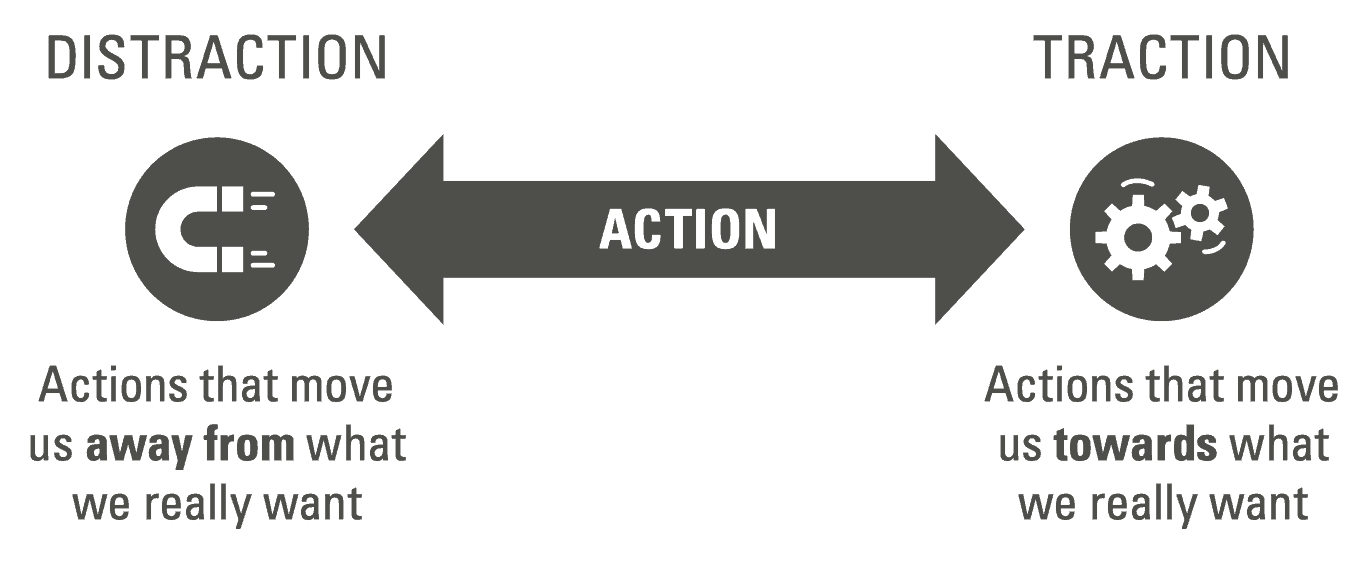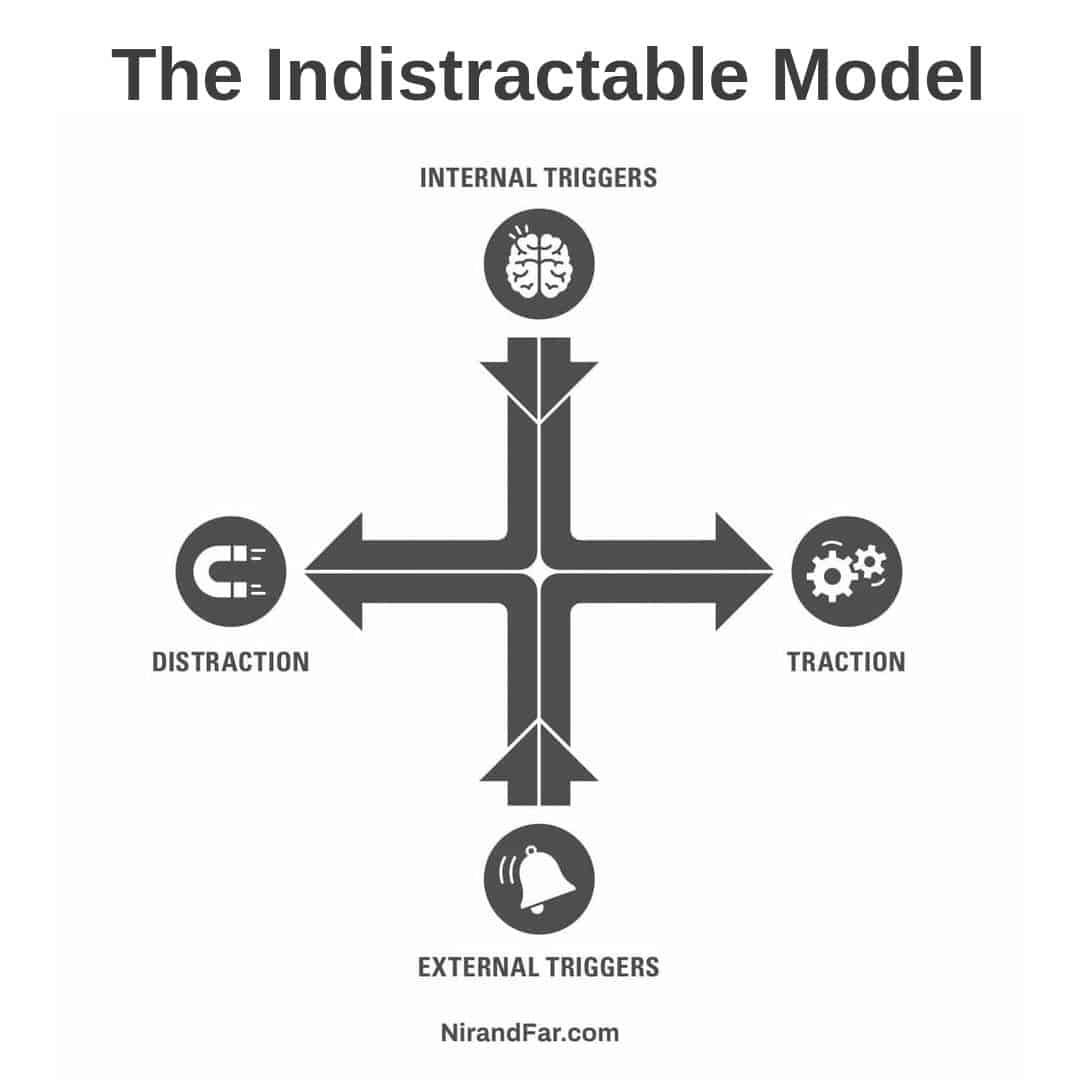How the difference between traction and distraction could transform your productivity
I know how distractions work from the inside. For over a decade, I’ve helped tech companies build products to keep you clicking. In fact, I wrote the book about it in 2014: Hooked: How to Build Habit-Forming Products. I wrote Hooked for companies who wanted to help their customers build healthy habits, like going to the gym regularly and eating right. But in the process of researching the book, I found that some products drew some people in too much, including me.
I remember sitting with my daughter one afternoon doing activities from a book written to help daddies and daughters bond. One exercise consisted of asking each other the following question: “If you could have any superpower, what would it be?” Between the moment I asked the question and when my daughter could answer, I felt a buzz in my pocket. A work email diverted my attention.
“Daddy?” she queried.
“Just a second,” I grunted. “I need to respond to one thing.” My eyes were glued to my phone, my fingers were tapping away at a response.
I wish I could tell you what she said in that moment, but I can’t. While she was telling me her dream superpower, I was busy staring at my phone. By the time I looked up, she had left the room.
I’d blown a perfect daddy-daughter moment because I was distracted. At that moment, I knew I needed to learn how to manage distraction. I wanted to get the best out of my tech gadgets, without letting the tech gadgets get the best of me.
If you asked me what superpower I’d want, I know the answer: I want the power to be indistractable. It’s the skill of the future.
We bemoan the fact that technology is becoming more pervasive and persuasive and complain that our devices are “hijacking” our brains. On top of all that, we just can’t seem to disconnect from work.
Hoping and waiting for tech companies to change their products or for your boss to finally learn to respect your time may take longer than you’re willing to wait. Although distractions aren’t necessarily your fault, they are your responsibility. It’s time to equip yourself to manage your distractions.
Let’s start with a definition of distraction.
According to the American Psychological Association Dictionary of Psychology, distraction is “the process of interrupting attention” and “a stimulus or task that draws attention away from the task of primary interest.” In other words, distractions draw us away from what we want to do, whether it’s to accomplish a task at home or work, enjoy time with a loved one, or do something for ourselves.
If distraction becomes a habit, we may be unable to sustain the focus required for creativity in our professional and personal lives. Worse, if we’re constantly pulled away from friends and family by distractions, we miss out on cultivating the relationships we need for our psychological well-being.
Digital distraction might manifest in looking at notifications that pop up on your phone — even during conversations with family, friends, or colleagues, interrupting focused work to check email — chatting with coworkers who pop by your desk when you intended to do focused work, or scrolling through your social media feeds when you planned to read a book.
The opposite of “distraction” is “traction.” Traction is any action that moves us towards what we really want. Tractions are actions done with intent. Any action, such as working on a big project, getting enough sleep or physical exercise, eating healthy food, taking time to meditate or pray, or spending time with loved ones, are all forms of traction if they are done intentionally. Traction is doing what you say you will do.

What prompts us to traction or distraction? All human behavior is cued by either external or internal triggers.
External triggers are cues from our environment that tell us what to do next. That can mean dings and pings that prompt us to check our email, answer a text, or look at a news alert. Competition for our attention can come from a person as well, such as an interruption from a coworker. Even an object can be an external trigger: your television set seems to urge you to turn it on by its mere presence.
Internal triggers are cues that come from within. When we’re hungry, we are cued to get something to eat; when we feel a chill, we put on a sweater. When we’re stressed or lonely, we might call a friend for support. Even the desire to feel pleasure is itself a state of uncomfortable craving. Internal triggers are negative feelings.
Since all behavior is prompted by either external or internal triggers, then both the actions we intend to take (traction) as well as those that veer us off course (distraction) originate from the same two sources.
Now we can draw a complete picture of what I call the “Indistractable Model”:

Step 1. Master Internal Triggers.
In order to overcome distractions, you need to understand what drives your behaviors — what prompts you to compulsively look at your phone or read one more email.
The root cause of human behavior is the desire to escape discomfort. Even when we think we are seeking pleasure, we’re actually driven by the desire to free ourselves from the pain of wanting.
The truth is, we overuse video games, social media, and our cell phones not just for the pleasure they provide, but also because they free us from psychological discomfort.
Distraction, then, is an unhealthy escape from bad feelings. Once you can recognize the role internal triggers like boredom, loneliness, insecurity, fatigue, and uncertainty play in your life, you can decide how to respond in a healthier manner. You can’t control how you feel, but you can learn to control how you react to the way you feel.
To start, you can change how you think about the bad feelings that can lead to distraction. Studies show that not giving into internal triggers can backfire. Resisting a craving or impulse can trigger rumination and make the desire grow stronger. When you finally give in, relieving that tension of wanting increases the reward, reinforcing a bad habit. Thankfully, there are smarter ways to cope with discomfort.
Dr. Jonathan Bricker, of the Fred Hutchinson Cancer Research Center in Seattle, has developed a set of steps we can take when faced with a distracting temptation. His techniques help patients reduce health risks through behavioral change.
- Identify the feeling or thought behind your urge: When you find yourself about to become distracted, find the internal trigger that is prompting you to do so. Are you feeling anxious, restless, maybe even poorly qualified for the task?
- Write it down: Bricker advises that you write down that feeling, along with the time of day and what you were doing when you felt that internal trigger. Keeping a log of distractions will help you link behaviors with their internal triggers. The better you become at noticing the thoughts and feelings that precede certain behaviors, the better you will become at managing them over time.
- Explore the sensation: Bricker advises getting curious about the sensations that precede distraction. Do you get butterflies in your stomach? A tightening in your chest? Bricker recommends that you stay with that feeling before following your impulse. He recommends trying the “leaves on a stream” method. Imagine yourself beside a stream, on which leaves gently float by. Place each thought and negative feeling in your mind on one leaf and watch them float away.
Step 2. Make Time for Traction
In this day and age, if you don’t plan your day, someone else will! Without knowing what it is you want to do with your time, everything is a potential distraction. To make time for the things that really matter, follow these steps.
- Don’t pick your goals, pick your values: Values are the attributes of the person you want to become. Examples of values might include being a contributing member of a team, being a loving parent, being in an equitable marriage, seeking wisdom, taking care of your physical fitness, or being a generous friend. Only you can decide which values are important to you.
- Turn your values into time: Many people talk a good game about what’s important to them — family, health, friends. But when it comes to investing time in these areas of their lives, they get distracted and don’t follow through. They don’t live up to their values because they don’t make time for them in their day.
- Timebox your schedule: The most effective way to make sure you’ll make time for your values is timeboxing. Timeboxing means deciding what you’re going to do and when you’re going to do it. The goal is to create a template for how to spend your time each day, eliminating all white space in your calendar.
It doesn’t matter what you do as long as you do what you planned to do. Go ahead and scroll through social media, but at allotted times — not at the expense of other things you planned to do, like spending time with your family.
Decide how much time you want to devote to each domain of your life, according to your values. Make sure that you schedule enough time for yourself and for your relationships. After all, the most important people in your life deserve better than the leftover time in your day. Then, create a weekly calendar template for your perfect week. You can use a blank template and our free schedule maker. Next, include 15 minutes per week to reflect and refine your calendar for the week ahead.
Step 3. Hack Back External Triggers.
Tech companies use external triggers to hack our attention. The pings and dings from our devices often distract us by pulling us away from what we really want to do. We may try to ignore those triggers, but research shows that ignoring a call or message can be just as distracting as responding to one.
Not all external triggers are distractions, however. If used to help you accomplish tasks, external triggers can remind you to do what you planned. The right approach is to ask whether the external trigger is serving you, or whether you are serving it. If the prompt leads you to traction, keep it. If it leads you to distraction, eliminate it.
External triggers are all around us. One of the most potentially troublesome sources of unhelpful external triggers is, of course, our smartphones. Whether it’s to keep in contact with family, navigate around town, or listen to audiobooks, this miracle device in your pocket has become indispensable. It can also be a major source of distraction, but you can take back your smartphone in four steps:
- Remove: Uninstall apps you no longer need.
- Replace: Shift where and when you use potentially distracting apps, like social media and YouTube, to your desktop computer instead of your phone.
- Rearrange: Move any apps that may trigger mindless checking from your phone’s home screen.
- Reclaim: Adjust your notification settings for each app to make sure only apps worthy of interrupting you can send external triggers.
Make sure to also “hack back” external triggers in other environments, both online and off. Whether the external trigger comes from a notification on your phone or laptop, or the interruption is a coworker taking you off track when you planned to do focused work, the consequences are the same.
Step 4. Prevent Distraction With Pacts.
Finally, the last step to becoming indistractable is to prevent distraction with pacts. This technique involves making a “precommitment” — removing a future choice — in order to overcome distraction.
Precommitments are decisions we cement well in advance of the temptations we know might come. As such, this step should only be taken after we have followed the first three steps and learned to manage our internal triggers, made time for traction, and hacked back the external triggers that pull us to distractions.
There are three types of pacts.
An effort pact is a kind of precommitment that involves increasing the amount of effort required to do something you don’t want to do. Adding additional effort forces you to ask if a distraction is really worth the extra effort. There are numerous apps designed to help you make effort pacts with your digital devices. (Good examples include Self Control, Forest, and Freedom, but there are many others.)
A price pact puts money on the line. If you stick to your intended behavior, you keep the cash. If you get distracted, you forfeit your funds. This kind of technique has had astounding results when used to help smokers quit. I used a price pact to finish the first draft of my book, promising my accountability partner $10,000 if I did not finish the draft by deadline. Fortunately, I kept my money and finished writing my book.
Finally, an identity pact is another way to change your response to distractions. Your self-image has a profound impact on your behavior. By taking on a new identity, you empower yourself to make decisions based on who you believe you are. Consider how people who call themselves “vegetarians” don’t have to expend much willpower to avoid eating meat.
To become indistractable, you can stop telling yourself you are a person with a “short attention span” or an “addictive personality” and instead tell yourself, “I am indistractable.” If you tell yourself you are the kind of person who is easily distracted, it instantly becomes true. However, if you believe that you are indistractable, you empower yourself to respond more healthily to whatever distractions get in your way.
The Most Important Skill of the Future
Becoming indistractable is not some mysterious formula. It’s as easy as following the four steps above. Mastering your internal triggers, making time for traction, hacking back your external triggers, and preventing distractions with pacts are all powerful tools that can reshape your life.
The world is splitting into two types of people: those who allow their attention and their lives to be manipulated by others, and those who proudly call themselves indistractable. When you become indistractable, you influence others to do the same. You can influence colleagues and coworkers to try these techniques. You can inspire your friends and family to pursue the lives they envision. You can help your children learn what is sure to be the skill of the century: the power to become indistractable.
Related Articles
- Schedule Maker: a Google Sheet to Plan Your Week
- Habit Tracker Template in Google Sheets
- The Ultimate Core Values List: Your Guide to Personal Growth
- Timeboxing: Why It Works and How to Get Started in 2024
- An Illustrated Guide to the 4 Types of Liars
- Hyperbolic Discounting: Why You Make Terrible Life Choices
- Happiness Hack: This One Ritual Made Me Much Happier

